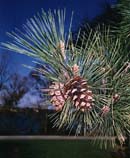 Foliage and cones on an ornamental in Seattle (USA), showing characteristic tomentum on young, elongating shoots [C.J. Earle, 19-Mar-1999]. | Pinus thunbergii ParlatoreCommon NamesJapanese black pine (4), KURO-MATSU, O-MATSU [Japanese] (2).Taxonomic notesSyn: P. thunbergiana Franco; P. thunbergii Lamb., nom. illeg.; P. massoniana sensu Sieb. & Zucc., non Lamb. It belongs to the large subsection Pinus, within which it seems to be most closely related to P. hwangshanensis and P. nigra (3, 7). Recent sequencing of its chloroplast genome (5) provides hope that its phylogeny will soon be well understood, but current understanding suggests that along with P. densiflora and P. yunnanensis, it may have found a warm-temperate refugium in central Asia during the mid-Tertiary, providing a plausible linkage to western Asian populations of P. nigra (6).DescriptionTree: To 40 m tall, with trunk often divided in the wide, dense, dome-shaped or flattened crown (3).Bark: Dark gray or purple-gray, scaly, longitudinally fissured (2, 3). Branches: Light brown with many bracts, thereafter becoming glabrous, often ridged (3). Shoots: When young, covered with a dense whitish tomentum that is highly distinctive among pines. Leaves: Winter buds white, slightly resinous, 1.5-2 cm long, ovoid, pointed. Needles 2 per fascicle, 7-12 cm long, 0.7-1.2 mm wide, acute, dark green, scabrous with minute marginal teeth, often twisted, persisting 3-4 years (2, 3). Cones: Short-pedunculate, conic-ovoid, 4-7 cm long, buff to brown-gray, opening in late winter to 3.5-6.5 cm wide. May be single, paired or (in selected cultivars where the pollen cones are replaced by seed cones) very numerous (20 or more) to a shoot (2, 3). Cone scales: Numerous, cuneate, the apophysis flattened and transversely rhomboidal, with a short-mucronate umbo, pale brown to buff; the scale stem dark purple-brown to blackish above, pale brown below; opening to 60-80° wide (c.f. P. hwangshanensis), 18-28 mm long, 8-12 mm wide (2, 8). Pollen cones: Seeds: Dark brown to black, 6 mm, with an articulate 12-16 mm wing. Wood: Similar species: P. nigra resembles it in form, foliage, bark and cone characters; see also P. hwangshanensis. RangeJapan: Honshu, Shikoku and Kyushu; S Korea (2). It is the dominant pine from the coast to about 1000 m elevation (4). USDA hardiness zone 6.Big TreeOldestDendrochronologyEthnobotanyWidely used as an ornamental, and requisite in Japanese gardens, where it provides structural and symbolic counterpoint to the red pine P. densiflora.Air pollution has caused needle chlorosis, reduced needle retention and a decline in community diversity in forests near Korean cities (4). ObservationsIt is reportedly very common in lowlands within its range. Thanks to its wide popularity as an ornamental, it can be seen through much of the temperate zone.RemarksSince the early 20th century, native populations of P. thunbergii have been decimated and may ultimately be eliminated by pine wilt disease, caused by the nematode Busaphelenchus xylophilus. The disease is native to North America, where it has no apparent ill effect on native pines, but the Asian pines P. luchuensis and P. thunbergii apparently have no resistance to it. It is introduced to needles when they are grazed by longhorn beetles (Coleoptera: Cerambycidae) and effectively defoliates the trees. As the trees die and are invaded by blue stain fungi, the nematodes begin to feed on the fungi. Longhorn beetles lay eggs in the bark of the dying trees, providing the nematodes with their transport vector. The nematode is also deadly to P. sylvestris, the world's most widespread pine species, and there is great concern in Europe that the nematode might one day reach that continent (1).Citations(1) Harrington and Wingfield in Richardson 1998.(2) Ohwi 1965. (3) Farjon 1984. (4) Richardson & Rundel 1998. (5) Wakasugi T., Tsudzuki J., Ito S., Nakashima K., Tsudzuki T. and Sugiura M. 1994. Loss of all ndh genes as determined by sequencing the entire chloroplast genome of the black pine Pinus thunbergii. Proceedings of the National Academy of Sciences, USA 91: 9794-9798. (6) Millar in Richardson 1998. (7) W. Y. Hsia. 1936. Flowering plants of Hwangshan. Contrib. Inst. Bot. Nat. Acad. Peiping 4: 155-156. (8) M. P. Frankis pers. obs. This page co-edited with M.P. Frankis. |
[Pinus] [Pinaceae] [home] This page is from the Gymnosperm Database |